- Table of Content
- 1.STCE at the UK...
- 2.Review of spac...
- 3.PROBA2 Observa...
- 4.International ...
- 5.Noticeable Sol...
- 6.Geomagnetic Ob...
- 7.The SIDC space...
- 8.Review of Iono...
- 9.Upcoming event...
2. Review of space weather
3. PROBA2 Observations (2 Sep 2024 - 8 Sep 2024)
4. International Sunspot Number by SILSO
5. Noticeable Solar Events
6. Geomagnetic Observations in Belgium
7. The SIDC space weather briefing
8. Review of Ionospheric Activity
9. Upcoming events
STCE at the UK Space Weather and Space Environment Meeting
The UK Space Weather and Space Environment Meeting was held from September 9-12 in Exeter, UK: https://iop.eventsair.com/ukswse2024/
The STCE presented its space weather education centre at the End Users Panel.
Sporadic and massive solar eruptions of very high-energy matter and radiation from the Sun can have an impact on navigation, communication and transport of energy. In extreme cases, these eruptions pose a safety risk to human health.
Businesses and organisations possibly impacted by space weather want to learn about this natural hazard to increase their resilience.
Not common understood yet by the end users
But, it is not always straightforward to read, understand and interpret space weather bulletins and data available on the internet. Some users might be in the initial phase of space weather awareness and understanding and might not have found their way to an easy accessible space weather service yet.
Fully client driven
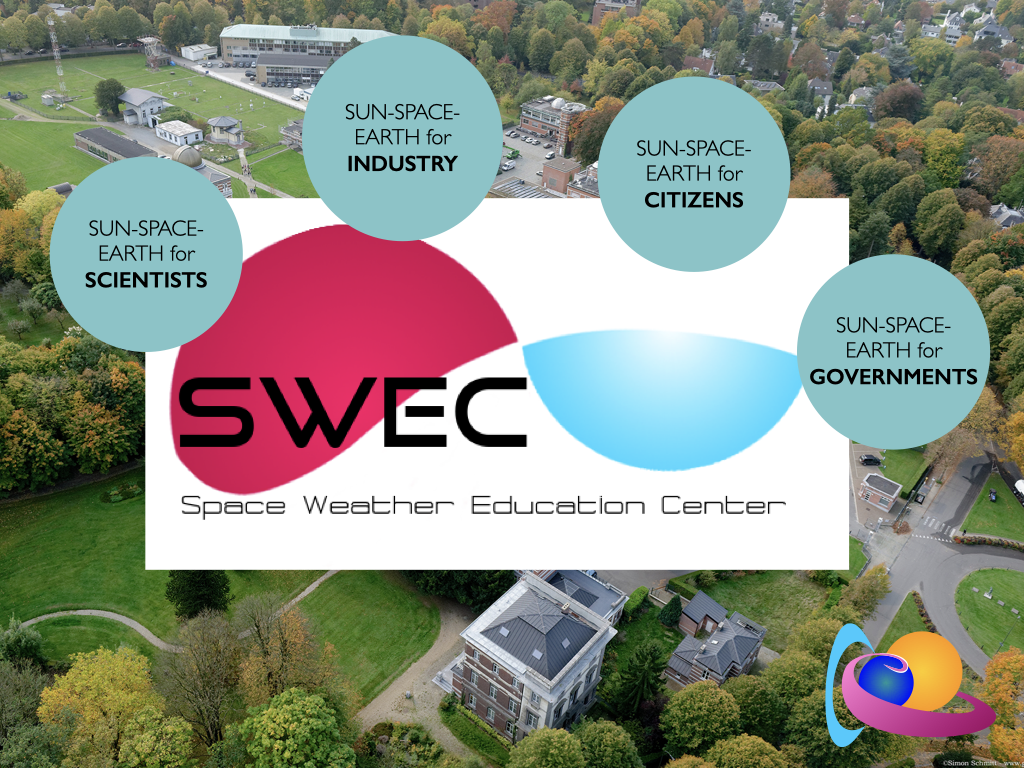
The Space Weather Education Centre, SWEC, offers basic and tailored courses for stakeholders that run space weather impacted operations and services. The courses address the barriers that users encounter while dealing with the question what space weather is, as well as where to find and how to interpret space weather parameters and indices.
This resulted in an offer of 4 specific courses. A fifth one is in the pipe line.
Fundaments of SWEC
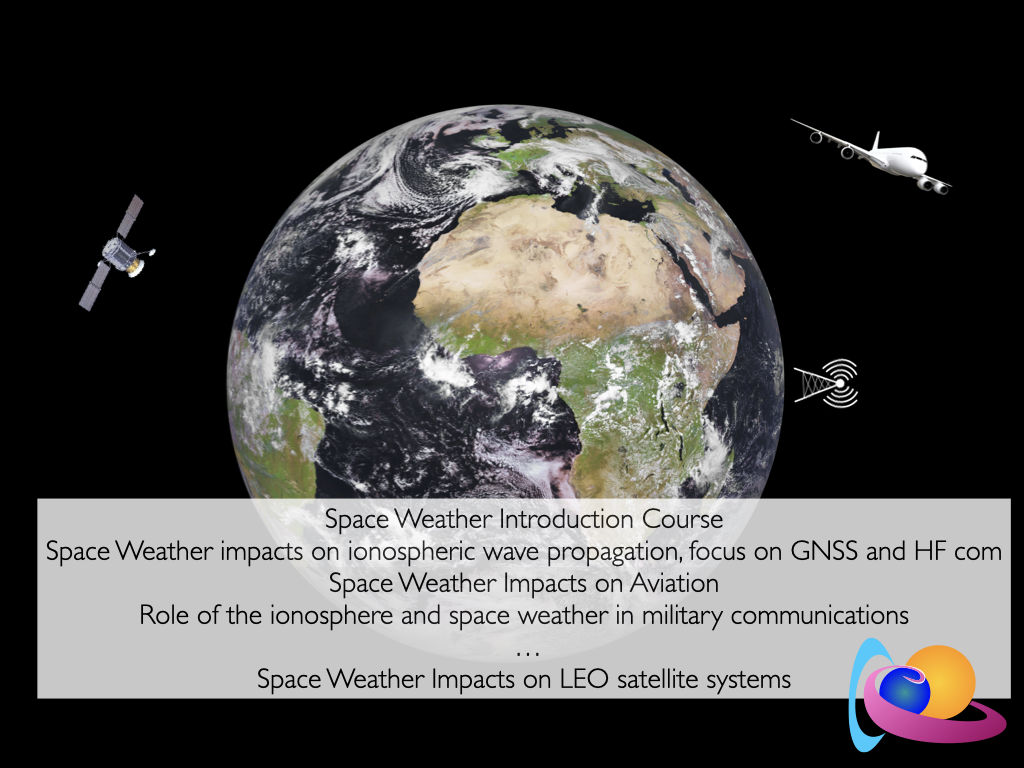
SWEC is an organisation of the STCE, the Solar-Terrestrial Centre of Excellence. The STCE is the place for research, data and services and education about Sun-Space-Earth and their interactions. The institute can rely on a rich history and expertise in solar and terrestrial observations and measurements, both on ground and from space. The STCE incorporates a Space Weather Service Centre, issuing daily space weather bulletins and warnings in case of space storms.
SWEC builds on this firm academic and service experience and has qualified teachers and communicators.
Check https://www.stce.be/SWEC
Review of space weather
Solar Active Regions (ARs) and flares
Over the past week, solar activity has been moderate, with several C-class and M-class flares observed. The most significant flares were an M5.5 and M5.6 originating from active regions near the east limb at approximately 20 degrees south latitude, peaking at 13:22 and 13:31 UTC on September 4. Other notable flares originated from NOAA AR 3807 and AR 3806, both with a complex beta-gamma magnetic field configuration.
Coronal mass ejections
Several halo coronal mass ejections (CMEs) were observed in LASCO/C2 coronagraph images over the past week. Due to the location of their source regions, no impact on Earth was expected. However, a more recent CME, detected at 00:36 UTC on September 8, is associated with a filament eruption at 15 degrees North and 23 degrees West. The projected speed is approximately 600 km/s in the northwest direction, and this CME has been identified as potentially Earth-directed.
Coronal Holes
At the beginning of the week, a small negative polarity coronal hole (CH) spanning 30-50 degrees South crossed the central meridian. The high-speed solar wind from this CH is expected to affect Earth. Additionally, a small positive polarity CH, spanning 25-35 degrees North, began to cross the central meridian on September 2, with its stream expected to influence Earth's solar wind environment.
Proton flux levels
Over the past 24 hours, the greater than 10 MeV GOES proton flux increased but remained below the 10 pfu threshold, likely due to the long-duration M5.5 flare and a halo CME from September 1.
Electron fluxes at GEO
Electron fluxes measured by the GOES-16 satellite (greater than 2 MeV) remained below the 1000 pfu threshold.
Solar wind
At the beginning of the week, Earth experienced slow solar wind conditions, with speeds ranging between 300 and 495 km/s. The total interplanetary magnetic field (IMF) fluctuated between 5 and 12 nT, and the IMF southward Bz-component varied between -6 and 9 nT. On September 4, a solar wind shock was observed, likely linked to a coronal mass ejection (CME) from September 1, leading to enhanced solar wind conditions.
Geomagnetism
Over the past week, geomagnetic conditions ranged from quiet to unsettled globally and locally (NOAA Kp and K-Dourbes 1-3). Following a solar wind shock on September 4, conditions briefly became active (NOAA Kp and K-Dourbes 4).
PROBA2 Observations (2 Sep 2024 - 8 Sep 2024)
Solar Activity
Solar flare activity fluctuated from low to moderate during the week.
In order to view the activity of this week in more detail, we suggest to go to the following website from which all the daily (normal and difference) movies can be accessed: https://proba2.oma.be/ssa
This page also lists the recorded flaring events.
A weekly overview movie (SWAP week 754) can be found here: https://proba2.sidc.be/swap/data/mpg/movies/weekly_movies/weekly_movie_2024_09_02.mp4.
Details about some of this week's events can be found further below.
If any of the linked movies are unavailable they can be found in the P2SC movie repository here: https://proba2.oma.be/swap/data/mpg/movies/.
Tuesday September 03
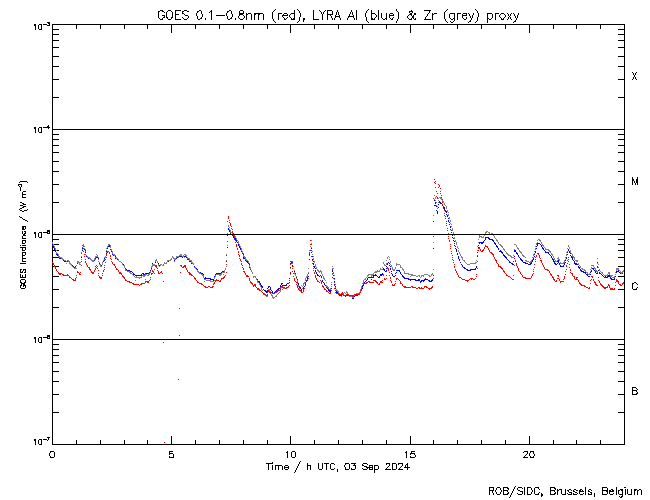
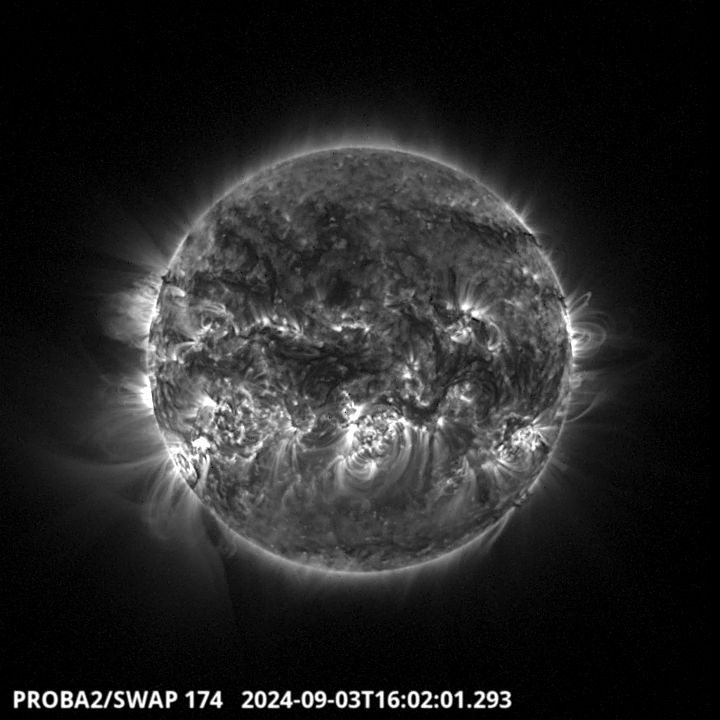
The largest flare of this week was an M3.3, and it was observed by LYRA (top panel) and SWAP (bottom panel). The flare peaked on 2024-Sep-03 at 16:02 UT. It occurred in the south-eastern quadrant, originating from active region NOAA3813.
Find a SWAP movie of the event here: https://proba2.sidc.be/swap/movies/20240903_swap_movie.mp4.
International Sunspot Number by SILSO
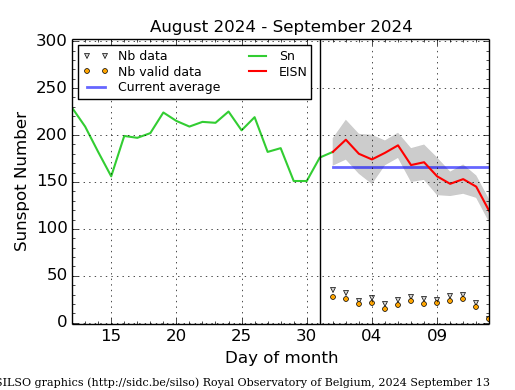
The daily Estimated International Sunspot Number (EISN, red curve with shaded error) derived by a simplified method from real-time data from the worldwide SILSO network. It extends the official Sunspot Number from the full processing of the preceding month (green line), a few days more than one solar rotation. The horizontal blue line shows the current monthly average. The yellow dots give the number of stations that provided valid data. Valid data are used to calculate the EISN. The triangle gives the number of stations providing data. When a triangle and a yellow dot coincide, it means that all the data is used to calculate the EISN of that day.
Noticeable Solar Events
| DAY | BEGIN | MAX | END | LOC | XRAY | OP | 10CM | TYPE | Cat | NOAA |
| 02 | 0518 | 0529 | 0549 | M1.9 | 3813 | |||||
| 02 | 1333 | 1343 | 1353 | M2.9 | 67 | 3807 | ||||
| 02 | 1957 | 2011 | 2028 | M1.4 | 67 | 3807 | ||||
| 02 | 2056 | 2102 | 2110 | M1.8 | 3813 | |||||
| 02 | 2235 | 2301 | 2330 | M1.5 | III/2 | 67 | 3807 | |||
| 03 | 0712 | 0722 | 0739 | S20E57 | M1.4 | S | III/1 | 77 | 3813 | |
| 03 | 1551 | 1602 | 1608 | M3.3 | 77 | 3813 | ||||
| 04 | 0243 | 0255 | 0311 | S22E49 | M1.4 | SF | 77 | 3813 | ||
| 04 | 0449 | 0456 | 0505 | S17W62 | M1.2 | SF | 67 | 3807 | ||
| 04 | 0555 | 0601 | 0607 | S12W12 | M1.0 | SF | 68 | 3806 | ||
| 04 | 0607 | 0611 | 0616 | S12W12 | M1.0 | SF | 68 | 3806 | ||
| 04 | 1308 | 1321 | 1327 | M1.0 | 77 | 3813 | ||||
| 04 | 1941 | 2000 | 2016 | S13E21 | M1.2 | 1F | 3811 | |||
| 05 | 0017 | 0020 | 0024 | S15W70 | M1.0 | SF | 67 | 3807 | ||
| 05 | 0312 | 0325 | 0337 | M1.1 | 68 | 3806 | ||||
| 05 | 0337 | 0344 | 0349 | M1.0 | 77 | 3813 | ||||
| 05 | 0847 | 0856 | 0901 | S16W72 | M2.8 | SF | 67 | 3807 | ||
| 05 | 0926 | 0942 | 0952 | M1.6 | 67 | 3807 | ||||
| 05 | 1320 | 1325 | 1335 | M1.3 | 67 | 3807 | ||||
| 07 | 0617 | 0749 | 0917 | S27E34 | M1.6 | 1F | 82 | 3815 | ||
| 08 | 1507 | 1530 | 1556 | S18W30 | M1.5 | 1N | 75 | 3811 |
| LOC: approximate heliographic location | TYPE: radio burst type |
| XRAY: X-ray flare class | Cat: Catania sunspot group number |
| OP: optical flare class | NOAA: NOAA active region number |
| 10CM: peak 10 cm radio flux |
Geomagnetic Observations in Belgium
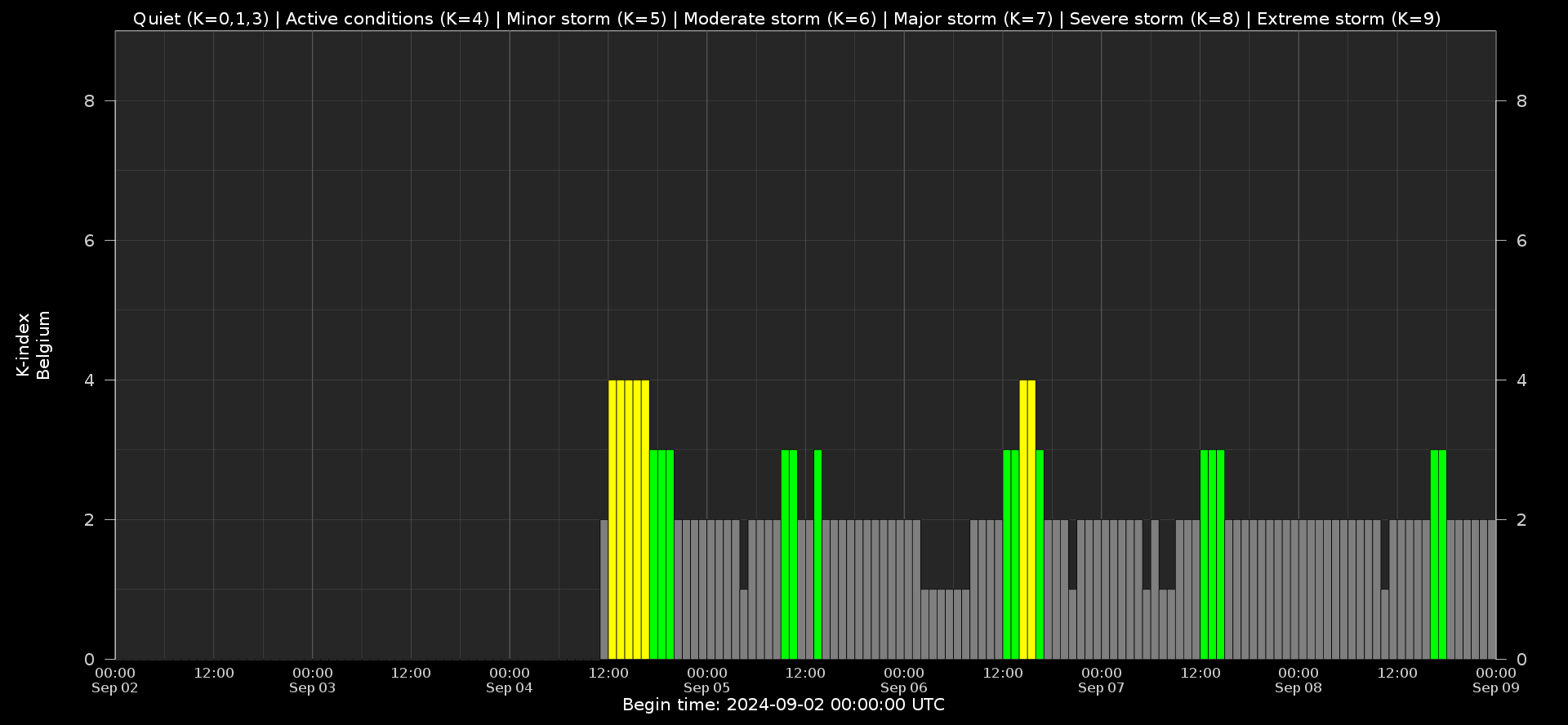
Local K-type magnetic activity index for Belgium based on data from Dourbes (DOU) and Manhay (MAB). Comparing the data from both measurement stations allows to reliably remove outliers from the magnetic data. At the same time the operational service availability is improved: whenever data from one observatory is not available, the single-station index obtained from the other can be used as a fallback system.
Both the two-station index and the single station indices are available here: http://ionosphere.meteo.be/geomagnetism/K_BEL/
The SIDC space weather briefing
The Space Weather Briefing presented by the forecaster on duty from Sep 1 to 8. It reflects in images and graphs what is written in the overview of space weather: https://www.stce.be/briefings/20240909_SWbriefing.pdf
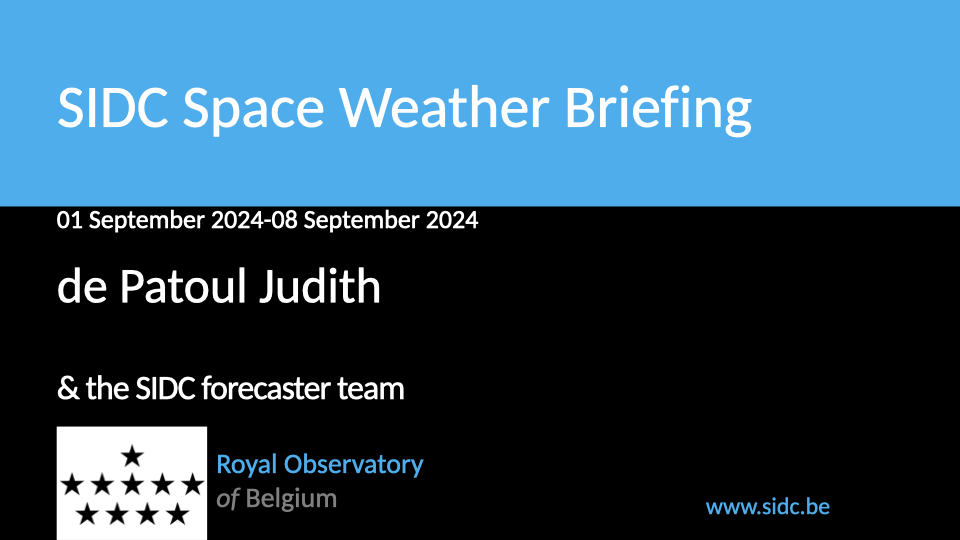
Review of Ionospheric Activity
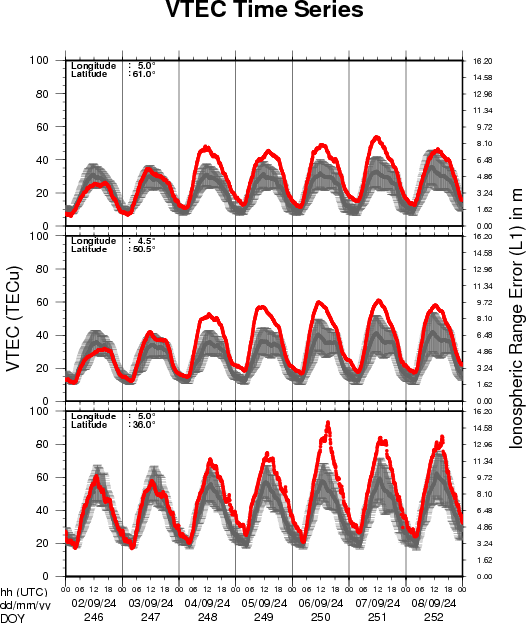
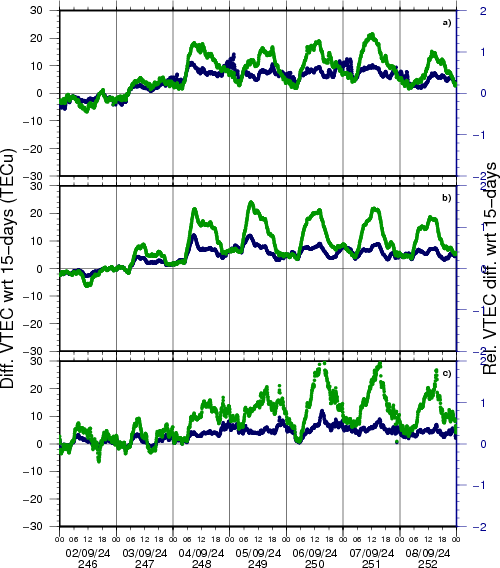
VTEC time series at 3 locations in Europe from 2 Sep 2024 till 8 Sep 2024
The top figure shows the time evolution of the Vertical Total Electron Content (VTEC) (in red) during the last week at three locations:
a) in the northern part of Europe(N 61deg E 5deg)
b) above Brussels(N 50.5deg, E 4.5 deg)
c) in the southern part of Europe(N 36 deg, E 5deg)
This top figure also shows (in grey) the normal ionospheric behaviour expected based on the median VTEC from the 15 previous days.
The time series below shows the VTEC difference (in green) and relative difference (in blue) with respect to the median of the last 15 days in the North, Mid (above Brussels) and South of Europe. It thus illustrates the VTEC deviation from normal quiet behaviour.
The VTEC is expressed in TECu (with TECu=10^16 electrons per square meter) and is directly related to the signal propagation delay due to the ionosphere (in figure: delay on GPS L1 frequency).
The Sun's radiation ionizes the Earth's upper atmosphere, the ionosphere, located from about 60km to 1000km above the Earth's surface.The ionization process in the ionosphere produces ions and free electrons. These electrons perturb the propagation of the GNSS (Global Navigation Satellite System) signals by inducing a so-called ionospheric delay.
See http://stce.be/newsletter/GNSS_final.pdf for some more explanations; for more information, see https://gnss.be/SpaceWeather
Upcoming events
Courses, seminars and presentations with the Sun-Space-Earth system and Space Weather as the main theme. We provide occasions to get submerged in our world through educational, informative and instructive activities.
* Sep 17, STCE seminar - Long Term Solar Activity Using mm Indicators + Investigating the Origin of Switchbacks in the Solar Corona using Statistical Approach, Space Pole, Brussels
* Sep 23, STCE seminar - Measuring wind speeds visually from PSP/WISPR's moving vantage point
+ Measuring photospheric bright points' shapes to constrain wave heating of the solar corona, Space Pole, Brussels
* Sep 27, STCE at the Wisenight Science festival in the Planetarium, Brussel, https://wisenight.eu/
* Sep 30 - Oct 3, STCE Space Weather Introductory Course, Brussels, Belgium - Registrations are complete - https://events.spacepole.be/event/204/
* Oct 2, STCE Seminar - Solar Eruptions: Mechanisms and Modeling, Space Pole, Brussels
* Nov 25 - 27, STCE course: Space Weather impacts on ionospheric wave propagation, focus on GNSS and HF, Brussels, Belgium - Registrations are open, https://events.spacepole.be/event/206/
* Dec 5-6, STCE Course Space Weather impacts on aviation, Brussels, Belgium - Registrations are open, https://events.spacepole.be/event/205/
To register for a course and check the seminar details, surf to the STCE Space Weather Education Center: https://www.stce.be/SWEC
If you want your event in the STCE newsletter, contact us: stce_coordination at stce.be
